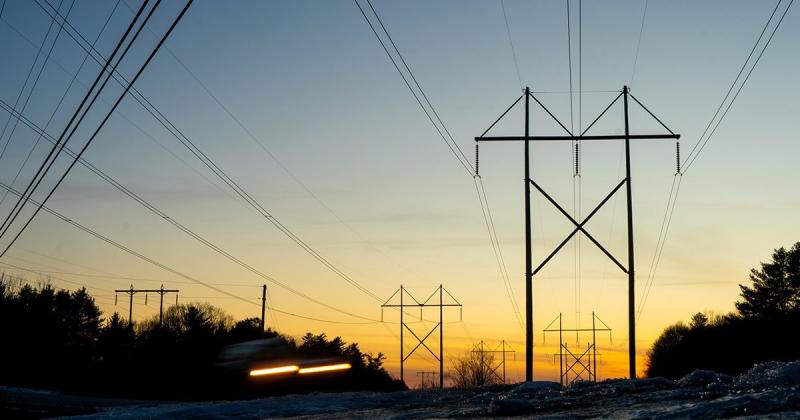Maine will coordinate plans for new transmission lines — particularly regional projects to share power from offshore wind farms — with nine Northeast neighbors, under a major agreement announced last week.
“As we face down the challenge of climate change, we know we cannot tackle this threat as individual states,” said the Massachusetts energy and environment secretary Rebecca Tepper in a release from the Maine Governor’s Energy Office. “We’re proud to see our ten states” — the six in New England plus New York, New Jersey, Delaware and Maryland — “working together like never before.”
This doesn’t make for the most exciting headline. For some, it might raise the specter of controversial developments like the CMP Corridor power line.
But experts agree that transmission lines — big, long-distance power lines, versus the distribution wires strung along local streets — are a crucial part of tackling climate change while controlling costs and shoring up reliability for everyday energy users.
The reason: Electrification, increasingly powered by renewables, especially the dawn of offshore wind.
“Now more than ever, our electric grid serves as the foundation from which we will continue to build our clean energy future,” said Christine Guhl-Sadovy, New Jersey’s top utilities regulator, in a press release.
Let’s first understand why moving off fossil fuels will require a bigger, better electric grid.
A recent federal report showed worsening gridlock in connecting new renewable energy projects to an aging, overloaded power system — one that’s staring down rising demand from the advent of fossil-free technology like heat pumps, induction stoves, electric cars and more. (Mainers may recognize this issue from headlines about snarled solar interconnection queues.)
The problem, in many cases, is that there’s not enough space to tie on new sources of power at existing substations and on existing power lines. Utility and regulatory studies that look for ways around these limitations, and decide who pays for them, can be slow and clunky.
New transmission lines aren’t the only solution — utilities can also upgrade existing infrastructure or implement “non-wires alternatives” — but they will be necessary, the federal study said.
It forecast that the U.S. needs to expand its transmission system by 60% in the next six years and as much as threefold by 2050. It also cited research showing that “inter-state coordination and transmission expansion would reduce the system cost of a 100% clean power system by 46% compared with a hypothetical state-by-state approach.”
A new federal rule will require utilities to work together on transmission planning within their regions. Ari Peskoe, the director of Harvard’s Electricity Law Initiative, told Dan Gearino of Inside Climate News in May that the success of this mandate will depend on whether utilities, state regulators and other stakeholders decide to really assess their regions’ needs.
He noted that “the provision will be useful in places where the participants have a history of working together, such as in New England.”
Enter the Northeast states’ newly signed memorandum of understanding, creating a “non-binding framework to coordinate enhanced interregional transmission planning and development.” It builds on a first-in-the-nation collaborative the states launched last year, in coordination with federal authorities.
Just as no one state is alone in its experience of increasing weather extremes driven by fossil fuel emissions, New Jersey Gov. Phil Murphy said in a press release, “we are also not alone in our response to the intensifying climate crisis.”
One focus of the new effort will be to set up standards and processes for disseminating power from offshore wind projects.
This is the other big driver of transmission pressures in coastal regions. Located in federal waters many miles offshore, these huge new wind projects will require new transmission — such as undersea cables with landings on shore — to connect to the terrestrial grid.
But the scale of wind does not fall neatly within state lines. Consider that the federal planning task force for wind in the Gulf of Maine includes stakeholders from Maine, New Hampshire and Massachusetts. Or take the New York Bight, a wind leasing area that stretches from Long Island down the New Jersey coast.
“The Eastern Seaboard is home to three independent system operators, each with its own transmission planning processes, making state cooperation across regional grid boundaries critical to cost-effectively meeting state clean energy goals,” the Northeast transmission collaborative says on its website.
Under the new MOU, member states will “coordinate on technical standards for offshore wind transmission equipment” to ensure that projects fit together flexibly as they come online across the coast in the coming years, “preserving the ability to interconnect regions as the industry matures.”
It’s a way of working smarter, not harder, and avoiding the need to reinvent the regulatory wheel in each state as neighbors pursue parallel energy solutions with overlapping infrastructure needs, costs and impacts.































